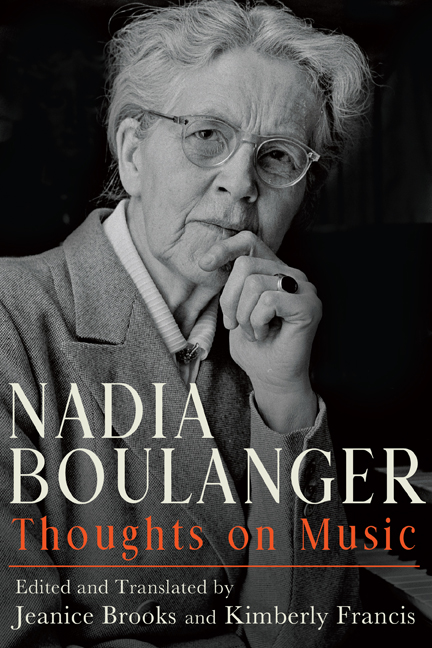Book contents
- Frontmatter
- Contents
- List of Illustrations
- Acknowledgments
- Editorial Apparatus and Critical Notes
- Note on Translations
- List of Abbreviations
- Timeline of Nadia Boulanger’s Life
- Introduction
- Part One Journalism, Criticism, Tributes
- Part Two Lectures, Classes, Broadcasts
- Bibliography of Nadia Boulanger’s Published Writing
- General Bibliography
- Index
“Les Grands Concerts, Figure humaine de Francis Poulenc” Spectateur 3, no. 106 (June 10, 1947): 4 (complete text)
Published online by Cambridge University Press: 15 October 2020
- Frontmatter
- Contents
- List of Illustrations
- Acknowledgments
- Editorial Apparatus and Critical Notes
- Note on Translations
- List of Abbreviations
- Timeline of Nadia Boulanger’s Life
- Introduction
- Part One Journalism, Criticism, Tributes
- Part Two Lectures, Classes, Broadcasts
- Bibliography of Nadia Boulanger’s Published Writing
- General Bibliography
- Index
Summary
Concerts Reviewed
May 22, 1947 (Théâtre des Champs-Elysées, Choeurs de la Radiodiffusion nationale belge)
Figure humaine, op. 121, Francis Poulenc (Frenchpremiere)
It was during the summer of 1943 that Francis Poulenc composed Figure humaine, on poetry by Paul Eluard and for double a cappella choir. The work's tone is established in the first measures. The basses alone sing, “De tous les printemps du monde, celui-ci est le plus laid” [Of all the springtimes in the world, this one is the ugliest]; the choir takes this up again and again: “le plus laid, le plus laid” [the ugliest, the ugliest]. The melodic contour, the harmonic tension, the disposition of chords, the silences, the declamation that defines the text in an intense and profound line, create a singularly strong and poignant atmosphere.
The contrasts, the subtlest of emotional nuances, will not stop the momentum that drives the work toward its conclusion. The rhythmic thrust is such that even the halts that punctuate the work serve to mark its continuity.
Intuition proposes, intelligence disposes.Nothing in this art, which seems entirely spontaneous, has been left to chance, not even its facility. Fear of the commonplace is frequently nothing more than a sign of weakness. Poulenc does not hesitate; he chooses or welcomes the commonplace; when it seems irreplaceable to him, he positions it properly—and produces the desired effect.
Eight sections comprise Figure humaine. In a certain sense, its writing is influenced by sixteenth-century techniques. The choirs oppose one another, come together. At times the dialogue occurs in large phrases, at times it comes together in quick, lightening fast ripostes. Seamless fluency does the bidding of the mind that directs, controls, and establishes the work's architecture, even when emotion seems to dominate it.
One would like to pause over this or that sonic combination, or exploration of interlaced vocal lines, some among them taking up the velvety sound generated by the low tessitura, while others, placed up high, become so clear; to demonstrate the mysteries and modulations that animate this music, to reveal how these secrets are never “tricks” or “effects” for Poulenc, but instead organic necessities. Perhaps this is not the place to enter into such technical considerations; yet, only the listener who becomes aware of them can truly “hear” [understand].
- Type
- Chapter
- Information
- Nadia BoulangerThoughts on Music, pp. 280 - 281Publisher: Boydell & BrewerPrint publication year: 2020

